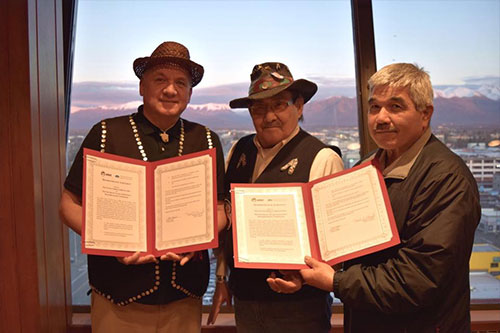
Alaska Tribes Unite to Protect Their Indigenous Ways of Life from Mega Mines
October 21, 2017
Kicking-off the Alaska Federation of Natives Conference week in Anchorage, the entities held a joint-reception on October 17. Together, the two groups include almost 30 federally recognized-Tribes spanning the Yup’ik, Dena’ina, Alutiiq, Tlingit, Ts’imshian, and Haida peoples who continue living their way of life in tune with natural cycles and keeping alive customary and traditional practices.
Designed to support each consortium’s mission to protect the indigenous way of life from the threat of mine development, the groups signed a formal Memorandum of Agreement, which marked a historical unification of Alaska Native tribes. The two entities released the following statements: “Our Tribes uniting their efforts to protect our peoples’ way of life from the mega-mines threatening our continued existence as indigenous people is an exciting and historic development,” said Robert Heyano, President of UTBB. “Our Tribes are under siege, but the unification of our people is a powerful move to defeat these toxic projects.” Southeast Alaska Indigenous Transboundary Commission Chairman Frederick Olsen, Jr. said: “Our groups share the value of ensuring the health of our homelands, and of the pristine lands and waters that support our traditional cultural practices and economy. With this agreement, we hope to amplify our voices throughout Alaska and across the Canadian border and together we can preserve our way of life for generations to come.” United Tribes of Bristal Bay’s member tribes represent 80 percent of the population of the region in fourteen Yup’ik, Denai’na, and Alutiq indigenous communities in Bristol Bay. UTBB’s mission is to protect the lands and waters that support the traditional way of life of the indigenous people of Bristol Bay by advocating against unsustainable large-scale hard rock mines like the Pebble project. The 14 United Tribes of Bristal Bay member tribes are: Togiak Traditional Council, Twin Hills Village Council, Manakotak Village Council, Curyung Tribal Council, Ekuk Village Council, Clark’s Point Village Council, Aleknagik Traditional Council, Portage Creek Village Council, New Stuyahok Traditional Council, New Koliganek Village Council, Levelock Village Council, Nondalton Village Council, Pilot Point Tribal Council, and Chignik Lake Tribal Council. The SEITC (formerly known as United Tribal Transboundary Mining Work Group) is comprised of fifteen Tribes of Southeast Alaska with a mission to protect Tribal lands and waterways for future generations, Olsen said. The 15 Southeast Alaska Indigenous Transboundary Commission’s Member Tribes are: Central Council of Tlingit and Haida Indian Tribes of Alaska, Chilkat Indian Village, Craig Tribal Association, Douglas Indian Association, Hydaburg Cooperative Association, Ketchikan Indian Community, Klawock Cooperative Association, Metlakatla Indian Community, Organized Village of Kake, Organized Village of Kasaan, Organized Village of Saxman, Sitka Tribe of Alaska, Petersburg Indian Association, Wrangell Cooperative Association, Yakutat Tlingit Tribe.
Editing by Mary Kauffman, SitNews
Source of News:
Representations of fact and opinions in comments posted are solely those of the individual posters and do not represent the opinions of Sitnews.
|
|||
